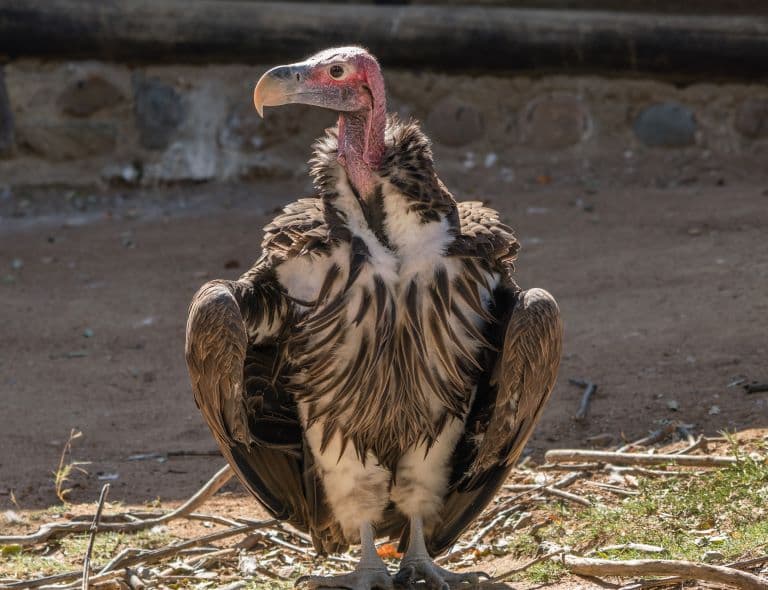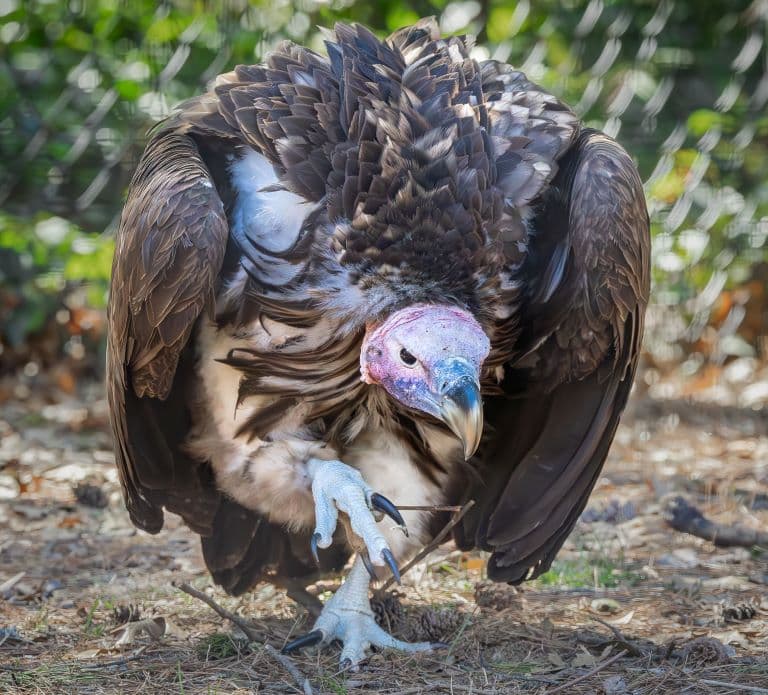Lappet-faced Vulture Profile
Vultures are already fearsome and creepy enough, but there’s a species in Africa that’s got it all.
Scary neck flaps, enormous power and size, a terrifying cackle, and a name Torgos, that sounds like a warrior from the Conan chronicles. Torgos, king of the plains, destroyer of flamingos, and all-round awesome bird, is sadly in need of our help.
The Lappet-faced Vulture is a distinctive, square-winged vulture with an enormous wingspan.

Lappet-faced Vulture Facts Overview
| Habitat: | Dry savannah, deserts, mountains, forest edges. |
| Location: | Africa, Arabian Peninsula, Kuwait. |
| Lifespan: | Up to 50 years |
| Size: | 115 cm (45 in) tall, 2.9 m (9.5 ft) wing span |
| Weight: | Up to 13.6 kg (30 lb) in captivity, closer to 9.4 kg (20.7 lb) in the wild |
| Colour: | Blackish with white thighs, bald head. |
| Diet: | Scavenger of carrion |
| Predators: | Humans |
| Top Speed: | Unknown |
| No. of Species: | 1 |
| Conservation Status: | Endangered (IUCN) |
One of the largest vulture species on Earth, it’s named after its skin folds, or lappets, and is a significant member of the carrion feeder class in its ecosystem.
But this formidable bird also hunts and doesn’t mind temporarily abandoning its solitary lifestyle to engage in wolf-like endurance pursuits with its unfortunate prey.
Tragically, this is a species that’s rapidly on the way out and without serious changes, might not last much longer.
Interesting Lappet-faced Vulture Facts
1. The loneliest vulture?
Unlike most vultures, these birds don’t share the bustling, crowded lifestyle of their peers, instead choosing to live mostly solitary lives, sometimes tolerating one another to the point of one or two neighbouring nesting pairs, but mostly going it alone.
On very rare occasions, there may be as many as ten nests in one spot, but this isn’t common, and even when foraging or visiting the watering hole, this vulture prefers the quiet life.
Breeding does force Lappet-faced vultures into bouts of companionship, and this is a rare glimpse of the social skills of the bird. Both males and females of the species collaborate on nest building and incubating, and they raise their young together.
By around 135 days, the chicks have fledged, and by a year later, they’re fully independent. By this time, the adults are ready for a break and can take a year off before finding the energy to come together again.

2. They’re incredibly strong
But this solitary nature doesn’t appear to bother the birds; they’re as tough as they come. Lappet-faced vultures have about the largest wing-span of any such bird in Africa and are one of the heaviest around.
These huge vultures are assertive and sometimes even aggressive and know how to use their size to their advantage, able to intimidate most animals of similar and smaller size away from a meal.
Only hyenas are dangerous enough to routinely push around these birds, who are powerful enough to eat large, thick-skinned prey like elephants; animals which other carrion-feeders wouldn’t be able to break into.
These large birds can store up to 1.5 kg (3.3 lb) of meat in their crops, and it isn’t always scavenged from carcasses, either. 1
3. They also hunt
As vultures, they’re expected to feed on carrion, but these birds are big and tough enough to hunt for themselves, too.
They’ve been seen feeding on young birds, particularly flamingo chicks, as well as baby impalas and guineafowl. They’ll sit on a branch and scan the ground, then strike from above to incapacitate their victim.
Their beaks, well-adapted for piercing through rhino hide, make short work of soft-bodied baby animals, and this hunt is sometimes another rare moment of collaboration for the species.

4. They work together to kill
Teams of vultures have been seen harassing flamingo colonies, isolating weaker birds and even attacking them in the air. Between four and seven vultures may team up to take down a victim, with the leader at the head followed by a supporting crew.
If the leader missed or gave up, another would take their place. This sort of relay approach can go on for several minutes, exhausting the flamingo and sealing its fate. At this point, all the hunting team descended upon the poor bird and finished it off hurriedly.
These hunting sessions appear to also be training events for juveniles. Young vultures were allowed to join the hunt, but would stay at the back and watch, then have to wait until last to take their cut.
These same vultures were seen to gradually master the hunt over the course of a month.

5. They ‘cackle’ like a witch
A lot of Raptors have very disappointing calls. Kestrels sound like a schoolyard whistle. [Crowned eagles], established hunters of primates, sound like your common beachfront gull. Even the iconic bald eagle sound from movies is stolen from the much grander red-tailed hawk.
Lappet-faced vultures, on the other hand, are as frightening to listen to as they are to look at. Their vocal repertoire consists of various hisses and cackles, which are employed at the site of the carcasses they share with one another. 2
6. Sadly, they’re in rapid decline
A small, rapidly declining population of these birds is all that remains of a once-widespread species across the African continent. As of 2016, they’ve been classified as Endangered, and by 2019 there were only 6500 mature individuals left.
With little improvement in the causes of their decline, likely, they will soon become critically endangered, and without serious interventions, extinct in the wild. 3
7. They face so many threats
Like all vulture species in Africa, and many worldwide, Lappet-faced vultures are suffering from a plethora of damaging effects, almost entirely human-made.
Poisons are a serious threat, placed by farmers to kill predators of livestock. Poisoned jackals ultimately end up inside carrion-feeders, and vultures are notoriously sensitive to this problem.
They’re also attacked deliberately, on account of them being big and scary. Many think they actively hunt livestock and will hunt and poison them in retaliation.
Increased vehicle presence and infrastructure damage nest sites and habitats, and electrocution from power lines contribute significantly to declines in their number.
They’re sometimes traded for traditional medicine, killed to cover up poaching activities and poisoned by anti-inflammatory drugs like Diclofenac, fed to livestock.
This outstanding barrage of dangers shows no sign of slowing down, and it is likely to mean the end of countless vulture species in the coming decades. 4
8. The Peregrine Fund is trying to help
Organisations like the Peregrine Fund focus on vulture conservation efforts in Africa, tracking vultures using radio transmitters to understand their movement patterns, particularly in relation to poisoning risks.
They also contribute to environmental education, raising awareness of the issues and solutions to relevant stakeholders, including local farmers.
The issue of poisoning must be addressed quickly, or this species cannot survive, and the fund’s focus on Rapid Response to Poisoning hopes to help with this. 5
Lappet-faced Vulture Fact-File Summary
Scientific Classification
| Kingdom: | Animalia |
| Phylum: | Chordata |
| Class: | Aves |
| Order: | Accipitriformes |
| Family: | Accipitridae |
| Genus: | Torgos |
| Species: | Tracheliotos |
Fact Sources & References
- “Lappet-faced Vulture (Torgos tracheliotos)”, Cincinnati Zoo & Botanical Garden.
- “Lappet-faced Vulture Torgos tracheliotos”, Data Zone.
- Author Name (Year), “Article Name”, Publication.
- “Lappet-faced Vulture”, IUCN Red List.
- “Lappet-faced Vulture”, The Peregrine Fund.
